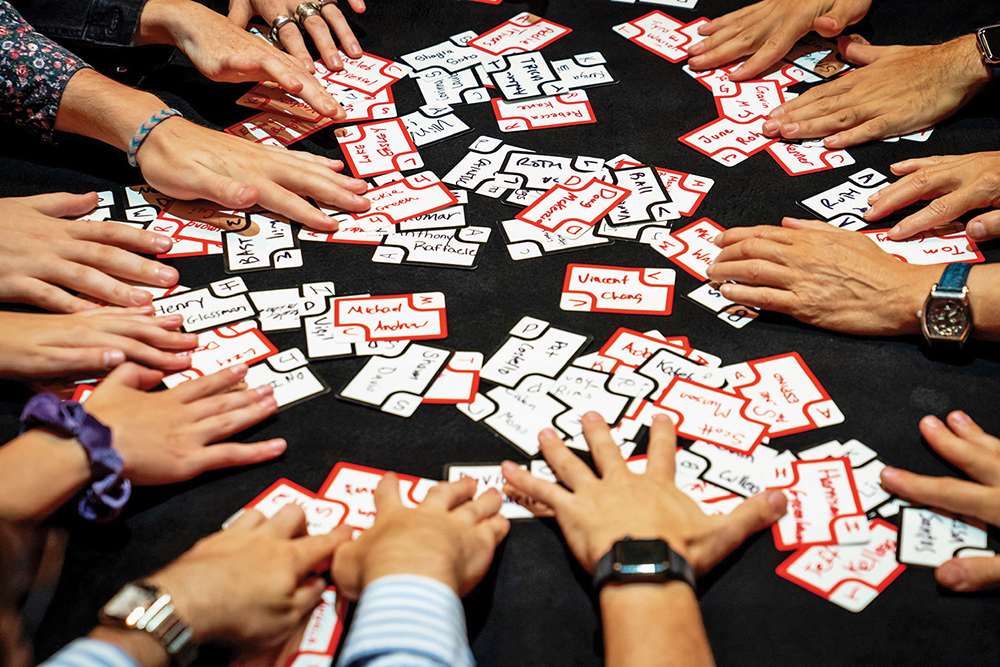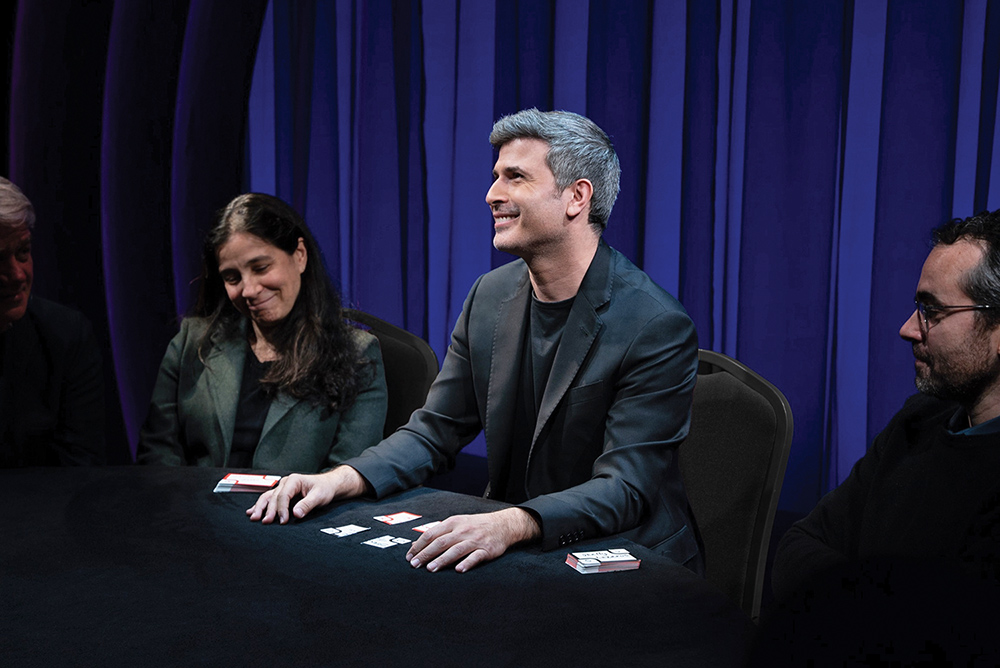
The crowd at Greenwich Village’s Judson Theatre chattered in anticipation, an eclectic mix of western pop and Arabic music playing in the background. The audience, roughly 100 people, were situated in three semi-circular tiers of steeply inclined stadium seating. The downward slope of the seats culminated at a round table, backed by a tall black curtain, seating an additional 10 audience members. Black-clad ushers mingled and chatted with the crowd as they awaited the performance by Israeli magician and mentalist Asi Wind.
The music stopped, the lights dimmed and the babble died away. The lights brightened after several moments to reveal a beaming Wind standing at the central table, arms spread wide as if to welcome his guests. His salt-and-pepper hair, black blazer, t-shirt and jeans recalled a Silicon Valley executive more than a magician.
Since September 2022, fans have been converging on this venue off Washington Square Park to see “David Blaine Presents: Asi Wind’s Inner Circle.” Wind rocketed to the pinnacle of the magic industry after media appearances including “Penn & Teller: Fool Us” and “The Kelly Clarkson Show.” Illusionist Blaine, a close friend, described Wind as his favorite magician, and mentalist Shlomo Levinger called Wind “one of the most incredible magicians alive.” His current residency at the Judson, at 32 shows per month, was recently extended to January 2024 due to its popularity and strong reviews.

For the next 90 minutes, Wind treated his audience to a unique blend of illusion, comedy and psychological musings. Upon arriving at the theater, each spectator had been handed a blank playing card and asked to write down their names. Relying solely on this unique deck, the magician performed feats of illusion and seemingly inexplicable telepathy, cracking Israeli-accented jokes all the while. Wind singled out audience members to serve as assistants for his tricks, leaving them both stunned and laughing. The nature of the evening’s card deck was such that the performance embraced the theme of names and the power they hold over their bearers.
Names, both past and present, play an important role in Wind’s personal history. He was born Asi Betesh in Holon, Israel, the son of a Syrian father and an Iraqi mother. Growing up in the Israel of the 1980s, Wind felt alienated by his Sephardic heritage. “There was no overt discrimination,” he remembered, “just a sense in the air that Ashkenazim were superior.” Sephardim often felt pressured to yishtaknez, or “Ashkenazify.” Wind, ashamed of his background, grew to loathe the Arabic music so beloved by his parents. “I complained every time they turned it on.”
Then Wind discovered magic. At the age of 13, he wandered into a magic shop on Tel Aviv’s Allenby Street, where a store employee performed a card trick. It was the first time Wind had ever seen one. The man asked the youngster if he’d like the trick for himself. Dazzled, Wind nodded. “That’ll be 50 shekels,” came the reply.
Wind was hooked. Turns out the magic shop offered a beginner’s class. He begged his father to let him register. He practiced obsessively and thought of almost nothing else.
From that point on, Wind never seriously considered another career, and the process helped him learn to embrace his roots. He enrolled in acting classes in his mid-teens to hone his performance chops. Asked to pick a song with personal meaning to sing for the class, Wind hearkened back to his parents’ house and the Arabic music he so hated. He chose “Inte Omri”—“You Are My Life”—by Egyptian sensation Om Kalthoum and, with the help of his Iraqi grandmother, learned the lyrics well enough to present it at class. Wind found that he loved Arabic music after all—the quarter tones, the operatic complexities, the hour-long song lengths. “This was the first time I accepted myself for who I was,” he said. From then on, the young man’s identity would play a starring role in his career.
In 2002, Wind traveled to New York to visit his brother. He instantly fell in love with the city. “It was like walking into a TV show,” he said. He canceled his return ticket and, to help pay the bills, started doing close-up magic for tips in Washington Square Park. It was a rough start, but he steadily built his reputation and began to book paying gigs. “In 20 years, I moved about 200 feet,” he quipped. “In another 20 years maybe I’ll make it to Canal Street.”
As his career progressed, Wind exchanged his Syrian surname for his current stage name. “I thought Betesh would be too hard for Americans to pronounce,” he explained, “Turns out they can’t say “Asi” either.” So how did he settle on Wind? “‘Betesh’ sounds like the Hebrew term for house fire, bet aish,” he joked. “It takes a strong wind to blow out a fire.”
In reality, Wind borrowed his name from celebrated Israeli photographer Noam Wind. The magician is himself an avid amateur photographer, as well as a talented painter and stand-up comedian. The only time he focused on something other than magic was the period he spent performing comedy on the open-mic circuit. Drawing on his dual passions, he took a cue from Steve Martin and developed a magic-comedy hybrid show. “My artistic pursuits inform one another,” Wind explained. “I believe it makes me a better, more well-rounded performer.”

A true magician’s magician, Wind also designs tricks for other artists. During his appearance on “Penn & Teller,” in a clip viewed 14 million times, hostess Alyson Hannigan asked Wind how he chooses which tricks to farm out and which to keep. “It’s a personality thing,” he replied. “Sometimes a great trick would never work for my personality.”
So how would Wind describe his magic personality? He has a ready answer: “Lighthearted and unpretentious.” Indeed, “Asi Wind’s Inner Circle” is nothing if not relaxed and jovial. Wind’s uniform of a t-shirt and blazer—“I hate suits and like t-shirts, so I split the difference with a blazer to class things up”—set the tone for the evening. While good-natured ribbing was worked into the show, Wind was careful to only involve audience members who welcomed the attention. “When you’ve done this as long as I have, you learn to read people and determine who wants to be involved and who’d rather be left alone,” he said. “My goal is for everyone to feel comfortable.”
Ultimately, Wind’s chief aim is to connect with people, and that pursuit has been driving him since his days as a street magician in Washington Square Park. The charismatic showman seeks to transform each night’s audience into a group of close friends.
This sense of friendship and bonhomie is the first illustration of the show’s name, “Asi Wind’s Inner Circle.” The second refers to the literal inner table in the center of the show, which serves as Wind’s performative base of operations. He closed out the performance by expanding on the third meaning: his personal inner circle—the magicians who inspired him. Intricate watercolors, painted by Wind himself, were projected on the central table as Wind discussed each in turn. Harry Houdini (born Erich Weisz), Chan Canasta (born Chananel Mifelw) and Juan Tamariz (born Juan Tamariz-Martel Negrón) each got their due. As Wind took a final bow and disappeared behind the black curtain, the crowd broke into applause. They dispersed knowing they had just observed a true master of his craft.
“Asi Wind’s Inner Circle” has been extended through January 27, 2024. Visit https://www.asiwind.com/ to purchase tickets.









